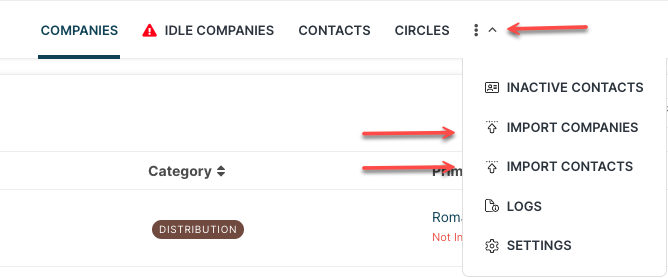
What is a CSV Import?
Instead of adding your Contacts and Companies manually or having them self-register, you can choose to bulk-add them via a CSV file import. CSV stands for "Comma Separated Values" and it's a very common method for importing/exporting data. It can be easily viewed as a standard spreadsheet. A CSV can be easily created using Microsoft Excel or Google Sheets as they both have built-in methods to export a CSV.
Before you're ready to import your Contacts/Companies, you will need to do some thinking about how your data will be configured. Will you be using Custom Fields?
CLICK HERE to learn about Custom Fields
CONTACT IMPORT
Currently, you can import the following:
- First Name
- Middle Name
- Last Name
- Primary Email
- Individual Address Items
- All default extra information fields (Work Email, Home Email, etc.)
- Tags
- Contact Custom Fields
- Company Custom Fields (Private and Public)
Then you can assign the following to each individual Contact:
- Role (Please note the Role you choose will affect which of the following actions are available)
- Company
- Company Category
- Primary Contact status (if applicable)
- Circle(s)
- Email Marketing Audience
- Event Generators
- On-Demand FLOW
- On-Demand Invoice Generator
- Accumulating Generator
- Recurring Generator
- Proposal Generator
- On-boarding FLOW
- Email/Form Cannons (if you have the
TIP: You'll need to have everything in order before Importing. It can be very time-consuming to remove imported data as there is no "undo" mechanism.
COMPANY IMPORT
If you are working with Companies you can import through the Company Import. This will still enable you to add the Primary Contact however the automation you add for the import will be aimed at the Company not the individual.
When you import your Company CSV you can either create new companies or update existing Companies.
Then you can assign the following to the company:
- Role (or you can choose to import all Contacts in the list as one particular Role)
- Primary Contact Email
- Primary Contact First Name
- Primary Contact Last Name
- Existing Primary Contact (from your existing Contacts)
You can also toggle to 'Prevent the Primary Contact from switching into individual mode'.

CLICK HERE to learn about preventing a Primary Contact from switching into ‘Individual Mode’.
Currently, you can import the following:
- Company Name
- Category
- Company Phone
- All default extra information fields (Work Email, Home Email, etc.)
- Skype
- Website
- Full Address
- Individual Address Items
- Background info
- Tags
- Company Public Custom Fields
- Company Private Custom Fields
HOW DO I PREPARE TO IMPORT MY CONTACTS/COMPANIES?
Before pulling the trigger on your Import, we highly encourage you to take some time to read through the sections below.
COLUMN HEADER & MAPPING
You can create a CSV file from scratch, or you can start with the sample CSV and then modify it as needed. When you're viewing the CSV in a spreadsheet viewer (Microsoft Excel, Google Sheets, Open Office, etc.), each row of the CSV (except Row 1) will be a Contact to be imported, and each column will be a data point associated with that Contact.
DOWNLOAD: Sample CSV Import File
IMPORTANT: Currently only CSV files in encoded in UTF-8 are supported. You can convert your CSV to UTF-8 through your choice of spreadsheet viewer.
Row 1 will serve as the Column Header where you will put the label for the data contained in that column. The values in Row 1 are not imported. Row 1 is used exclusively for identifying and mapping the columns.
HOW IS A ROLES ASSIGNED?
You have two options on how you will assign the Role to each of your imported Contacts.
Option 1
You can assign every imported Contact a specific role by choosing Lead, Prospect or Client from the first set of values in the Role selector.
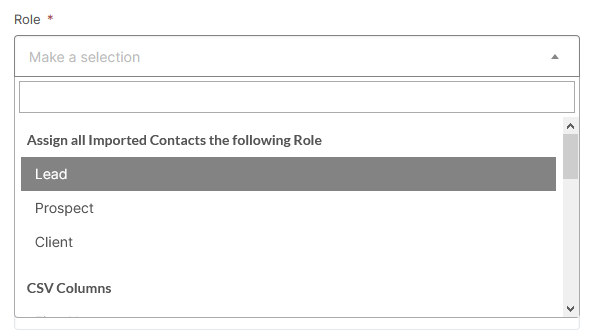
In the example above, every Contact imported during this operation would be imported as a Lead, regardless of how the CSV is configured.
Option 2
Or, you can include a Role column in your CSV and select that column using the Role selector. In this case, each Contact will have the Role assigned based on the value assigned to their row in the Role column.
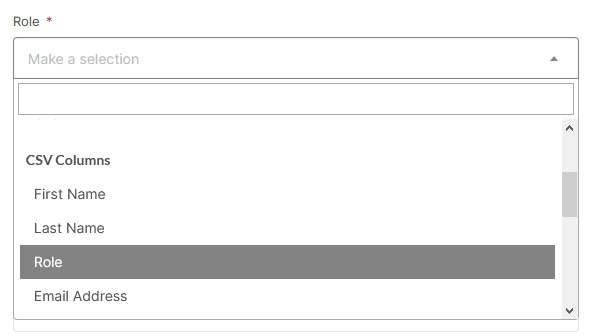
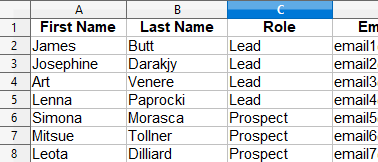
In this example, Art Venere will be given the role of Lead, while Simona Morasca will be given the role of Client.
How to Import Primary Contacts?
You can either Import through the Company CSV and assign your Primary Contact or you can create a Companies column in your Contact CSV along with a Primary Contact Column. The Deciding factor will be dependent on who you are wanting to aim the Automation/Actions to when you do import - the Individual or the Company?
EXISTING COMPANIES
If you want to assign Contacts to an existing Company during import, the Company will need to already exist in your account.
IMPORTANT: The Company name in the CSV will need to be an EXACT match the existing Company name in your account. That means if the Company name has capitalization, punctuation, or spacing, that should be carried over precisely to your "Company" column of your CSV.
NEW COMPANIES
If you want to import a new Company and assign Contacts to that Company during the import, select the option to create new Companies if no exact match is found.

The import will look for Companies in the CRM Company column, and associate each Contact with the Company that exists in that column. So, in the below example, James Butt, Art Venere and Lenna Paprocki will all be imported and associated with "Primus Associates, Inc".

In your CSV file, set a column with a header like Is Primary Contact. You can input the accepted values yes or no, or you can leave the cell empty.
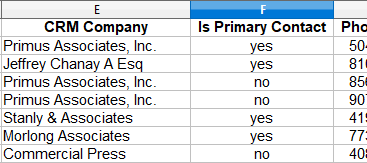
After uploading your CSV file you will see a mapping selector for designating the Primary Contact.
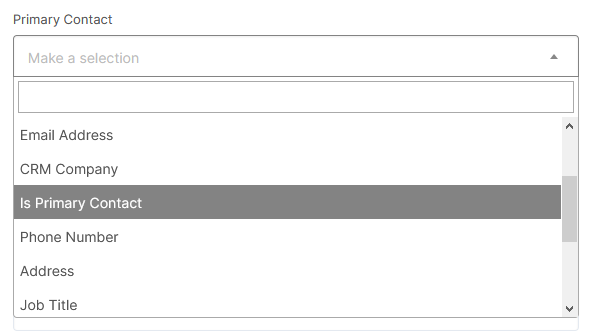
If the row is read as yes, then that Contact will be set as the Primary Contact for the associated Company. If the row is read as no, then nothing will be set. If the row is empty, then nothing will be set.
How do I Import Custom Fields with my Contacts or Companies?
If you will be using Custom Fields with your Contacts, ensure that those Custom Fields have already been created in the platform before Importing. You will then configure your CSV with a column for each Custom Field.

During the Import steps, you'll map the columns in your CSV to the Custom Fields you've already created in your account.
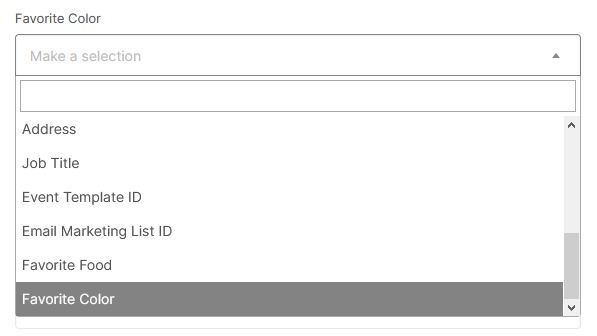
Certain Custom Field Types need to be mapped in a specific way to ensure that the import goes smoothly:
- Checkbox Type: Use checked / unchecked or 1 / 0. This is not case-sensitive.
- Datefield Type: Once you select your date format, you will need to make sure they all follow that same format.
- Radio Single Selection with multiselection disabled: The value from the uploaded file column should match with one of the options added to the custom field. This is not case-sensitive.
- Radio with Multiple Selections enabled: If the value from the uploaded file column contains a comma (delimiter) then the value will be split into multiple values, and each value will be validated if it matches one of the options of the custom field. All values which match will be added to the contact custom field. The delimiter: “,” (comma). For example: apple,pear,plum.
- Dropdown Type with multiselection disabled: The value from the uploaded file column should match with one of the options added to the custom field. This is not case-sensitive.
- Dropdown Type with multiselection enabled: If the value from the uploaded file column contains a comma (delimiter), then the value will be split into multiple values, and each value will be validated if it matches one of the options of the custom field. All values which match will be added to the contact custom field. The delimiter: “,” (comma). For example: apple,pear,plum.
If you hadn't added your Custom Fields beforehand, you have the option of adding them on the fly during the mapping phase of the Import.

Once you add a new Custom Field, you will be provided with a new field so that you can map it to the respective column in your CSV file.
DOWNLOAD: Sample CSV Import File
TIP: If you want to do an Import that includes data for Custom Fields already created in your account, the best way to get started is to Export data from your CRM Contacts or Company list. That CSV will already have the appropriate column headers for all of your existing Custom Fields, so you can use it as a template to build your Import CSV.

How do I execute the Import?
Importing is a three-step process - Choose the correct Import type (Companies or Contacts), upload your CSV, then map the columns.
STEP ONE
Go to CRM > Companies or CRM > Contacts and use the three dots to locate and choose your Import.

STEP TWO
Get started by uploading your CSV. Please note that there is no commitment after this step - nothing will be Imported until after finishing Step Three.
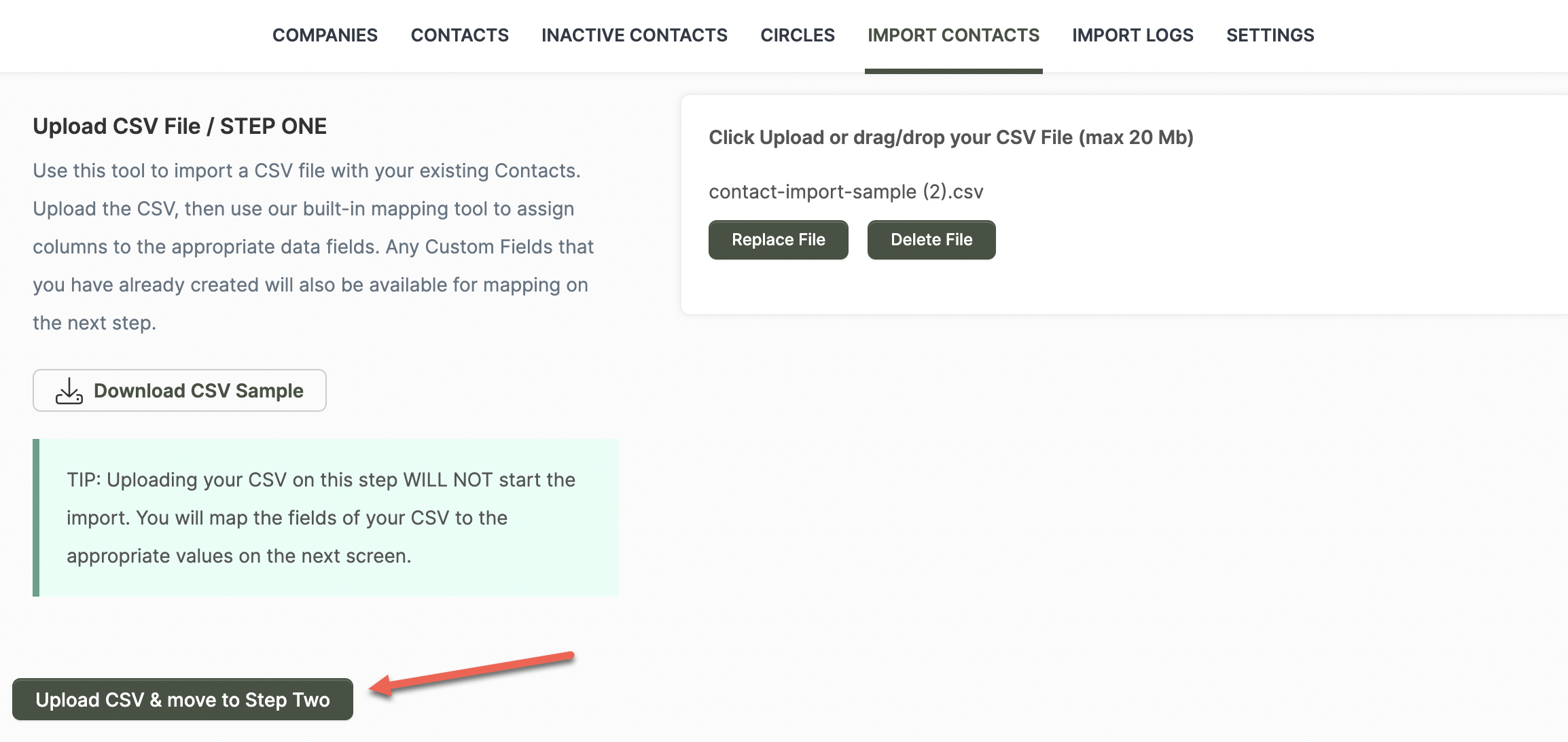
STEP THREE
After your CSV is uploaded, you will be directed to a page where you can associate the various columns in your CSV with the standard fields in your account, as well as any Custom Fields.

On this page, the existing fields in your account will be listed in the dropdown menus. Use the dropdowns to select the desired column headers that match up with the corresponding existing fields.

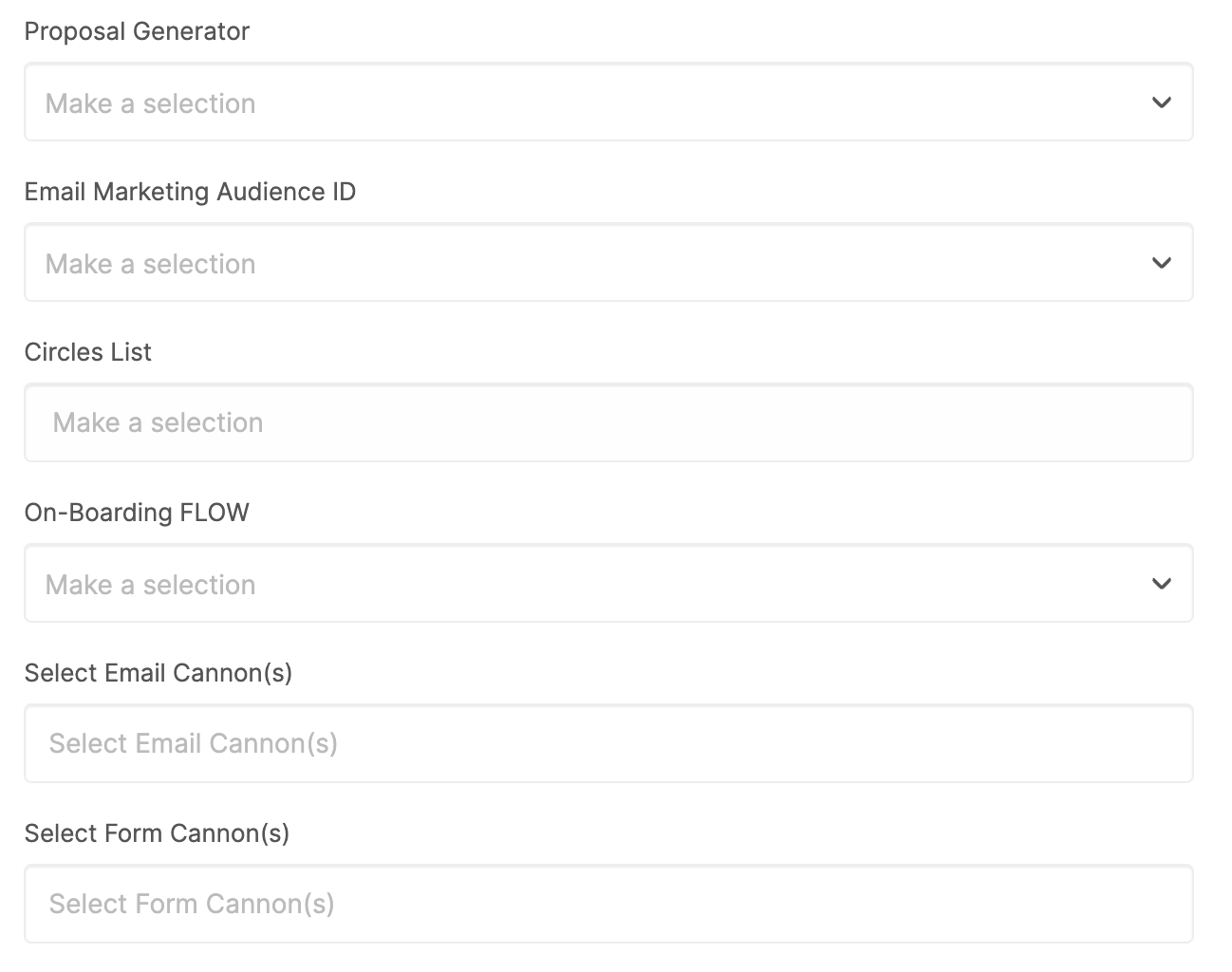
CLICK HERE to learn about Company Categories
CLICK HERE to learn about Event Generators
CLICK HERE to learn about FLOWs
CLICK HERE to learn about Invoice Generators
CLICK HERE to learn about Accumulating Generators
CLICK HERE to learn about Recurring Generators
CLICK HERE to learn about Proposal Generators
CLICK HERE to learn about Marketing Audiences
CLICK HERE to learn about Circles
CLICK HERE to learn about Cannons
IMPORTANT: This list will change depending on the Role selection. Do not be alarmed to see very few options when selecting Lead. This is expected as that Role does not have access to everything listed here.
You will also have a few additional Import Options presented to you before you initiate the action by clicking Import.
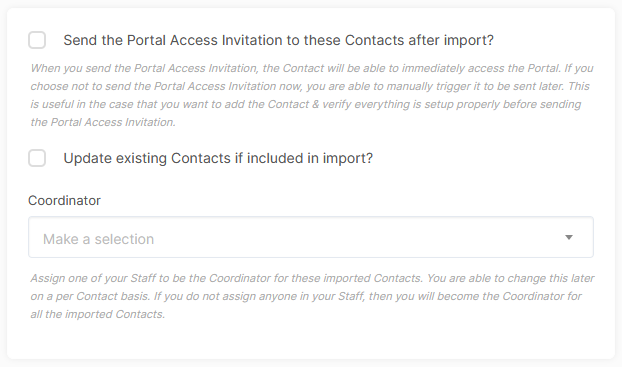
Portal Access Invitation: If checked, all Prospects/Clients that are imported will immediately be invited to the Portal. If left unchecked, then they will all be given a "Not Invited" status, which means they will not receive this email until it is manually triggered by you.
Update existing Contacts: If checked, any rows in the CSV that match with existing Contacts in your CRM (by having the same email address) will automatically be marked as "existing", and they will not be imported as new Contacts. Instead, the existing Contact's data will be overwritten by the data provided from the CSV file.
This feature is useful if you would like to like to update your existing Contacts' data in bulk, rather than having to update each one individually.
IMPORTANT: If you are Updating existing Contacts and you leave a field blank for a data point where existing data was present, that existing data will be overwritten and the existing data will be lost.
Coordinator: By default, the user Importing the Contacts will automatically be assigned as the Coordinator for all Imported Contacts. You can choose a different user from the dropdown menu instead.
Tips for Importing
Here are a few things to understand as you prepare for your import.
ASSIGNING BY ID NUMBER
If you are assigning Contacts to Event Generators or Email Marketing Audiences during import, you should use the numerical "ID" of these items in your CSV file. The ID numbers of Event Generators and Email Marketing Audiences can easily be found in the "ID" column of the tables in CRM > Events > Event Generators and Marketing > Audiences respectively. You will need to enter only the numerical ID of the desired Generator and/or List in your CSV, not the Name. Please see the example CSV attached to this post for an example.
IMPORTING VERY LARGE DATA SETS
Smaller CSV files will be automatically imported and you will see a success message. However, if the file is larger, you will see a message stating that the Import has been queued, and it will take a few minutes to be Imported.
TESTING YOUR CSV IMPORT
There is no UNDO mechanism for importing, so it's a good practice to test with only one or two rows of data before making the full Import. By doing this, you can save yourself a great deal of time in the case the Import doesn't work as you expect.
IMPORT LOGS: UNDERSTANDING ANY ERRORS
You can view the status of any Imports (pending and successful), as well as view specific errors related to problem Imports, by viewing the Import Logs.
Navigate to CRM > Contacts or CRM > Companies and click the three dots to reveal your option Logs in the top horizontal menu bar.

It will show you the file name, type, data source, how many rows are in that file, how many were successfully imported, the status of the import, and the creation date.

Clicking Options allows you to:
View Errors Log: This shows you the specific rows that caused errors in your import.
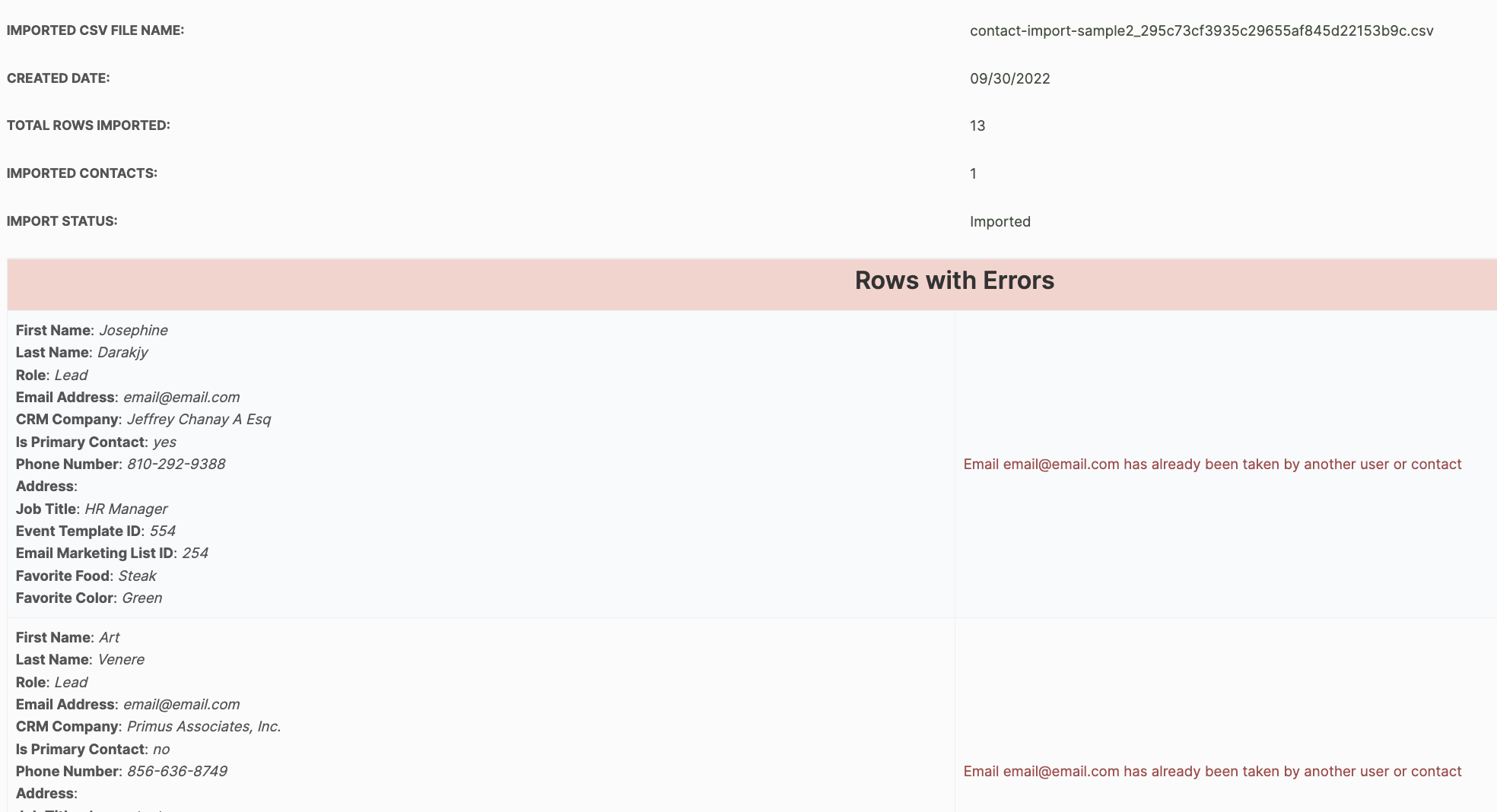
Download Errors Log: The original CSV with an extra column to show the errors will download to your device.
Download Original: The original CSV will download to your device.
Delete: This will remove that import from your logs. The system will ask you to confirm before deleting. Please note that this action cannot be undone.
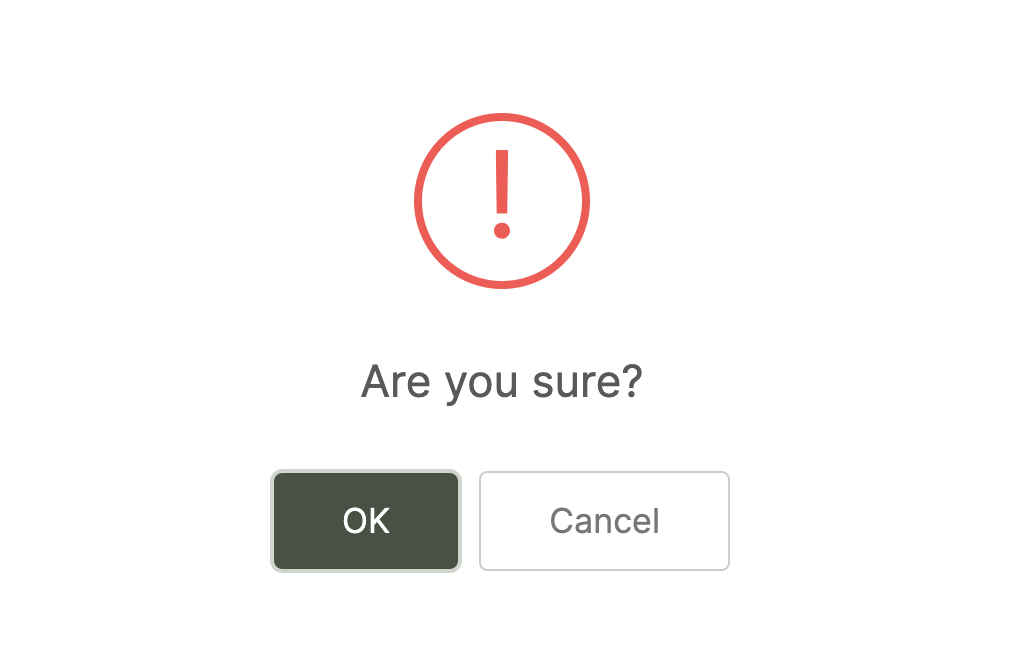
DOWNLOAD A SAMPLE CSV
This CSV is not meant to be static, but rather a starting point for you to help understand the concepts. Every scenario is different, so you'll want to modify, add to, rearrange, etc. your CSV before Importing.
This is an example of a Contact Import CSV
DOWNLOAD: Sample CSV Import File
What is CRM Exports?
The Contact and Company Export function allows you to export all or selected default and custom data for your Contacts. Once an export is initiated, you can download the CSV file.
Company Exports
To export your Companies you will want to navigate to CRM > Companies and then select the "Reports" button.
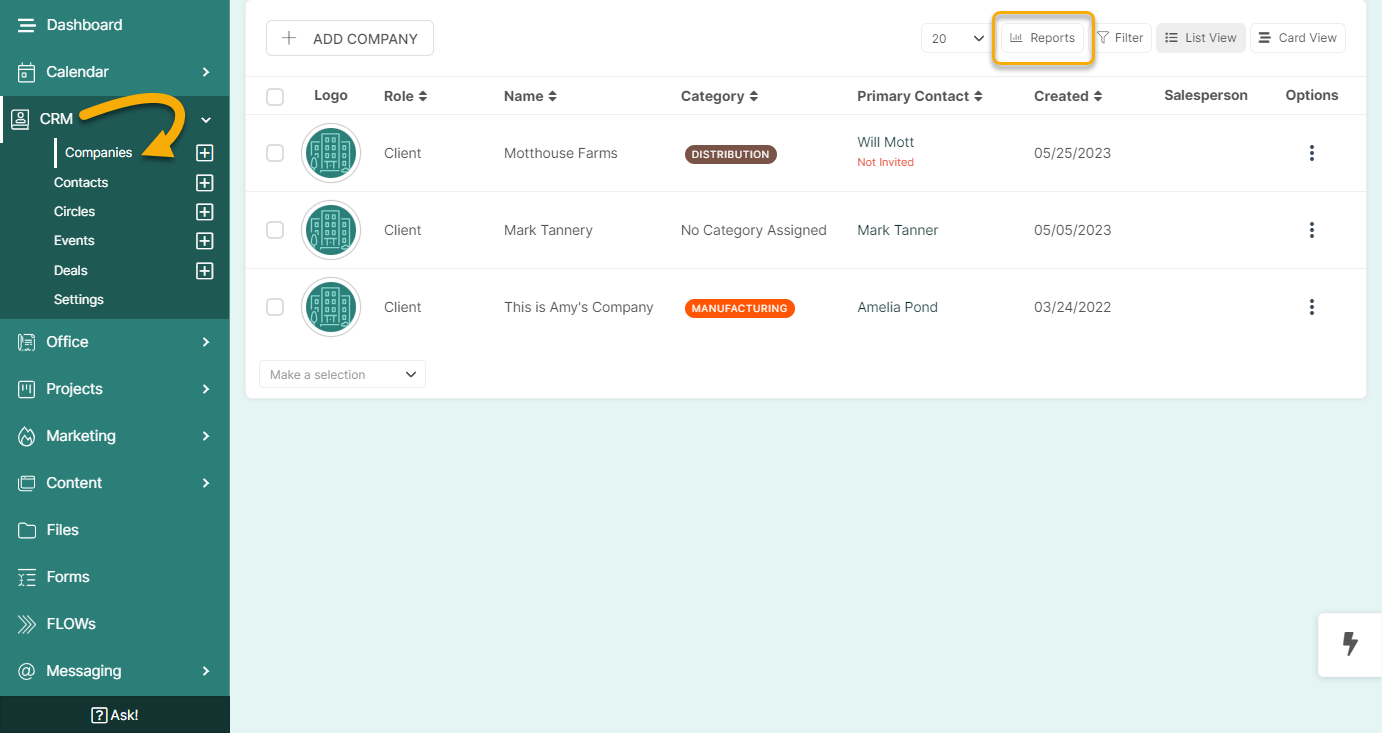
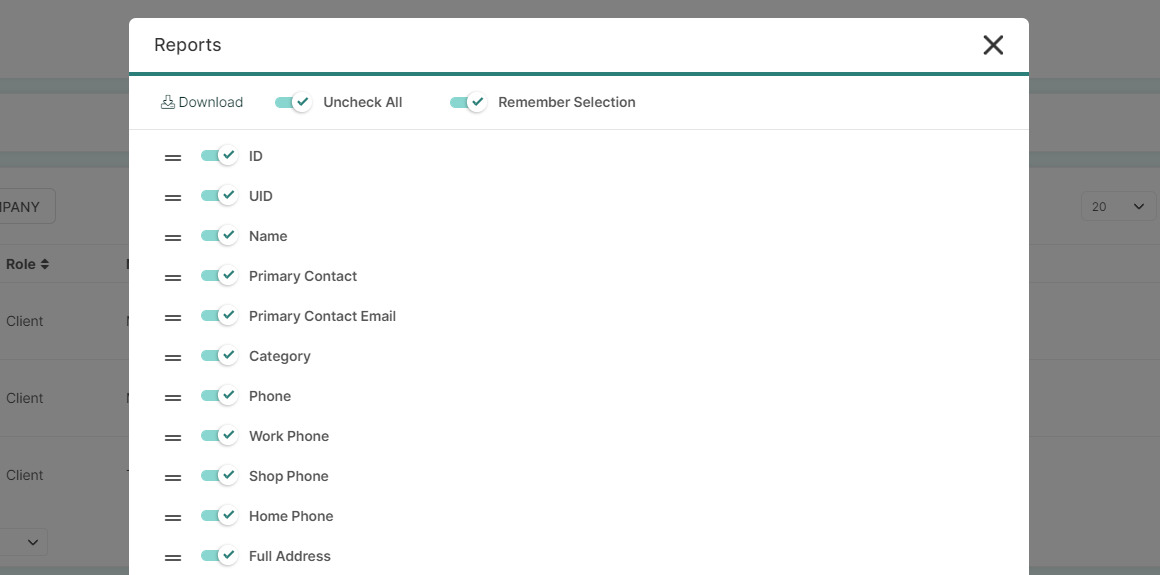
Download: Click this button when you are ready to initiate the export.
Uncheck/Check All: This toggle will update depending on what you have selected. Uncheck All will uncheck/toggle all of the fields below that are currently checked/toggled. Check All will check/toggle all of the fields below.
Remember Selection: Always running the same export? When this option is enabled the options selected and arranged bellow will be the default option the next time you go to run an export.
You can use the = icon to click and drag to arrange the fields in the order you would like to see them in the CSV.
Contact Exports
To export your Contacts or Individuals, you will want to navigate to CRM > Contacts and then select the "Reports" button.

This will open an options window where you can select and arrange the fields you would like included in the export.
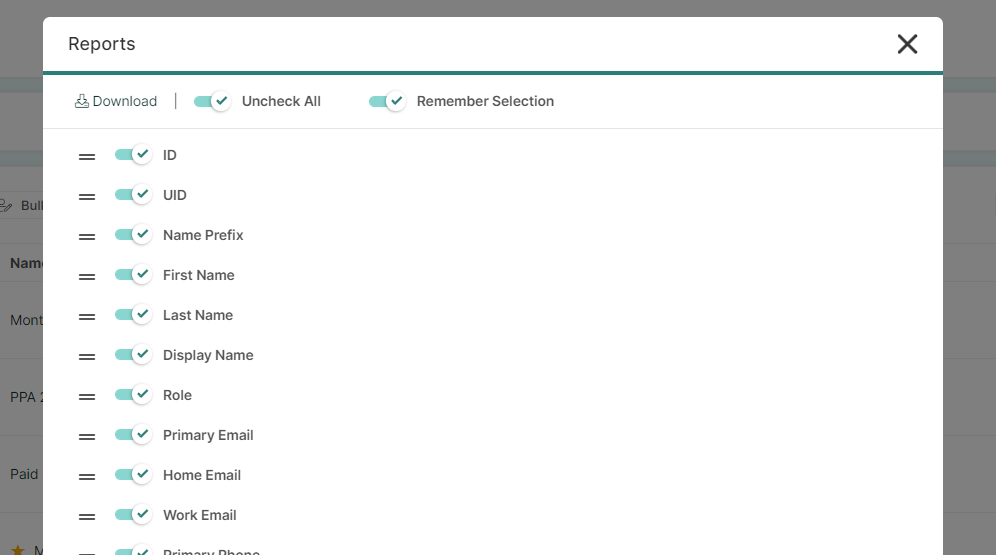
Download: Click this button when you are ready to initiate the export.
Uncheck/Check All: This toggle will update depending on what you have selected. Uncheck All will uncheck/toggle all of the fields below that are currently checked/toggled. Check All will check/toggle all of the fields below.
Remember Selection: Always running the same export? When this option is enabled the options selected and arranged bellow will be the default option the next time you go to run an export.
You can use the = icon to click and drag to arrange the fields in the order you would like to see them in the CSV.
What happens after an Export?
After you initiate an export you will be redirected to the Export/Import Logs page. You should see a message at the top of the page indicating that a request has started and you will be notified by email when complete.
When the export has completed, you will be notified by a system email and you will have the option to download directly from the email or via the Export/Import Logs page.
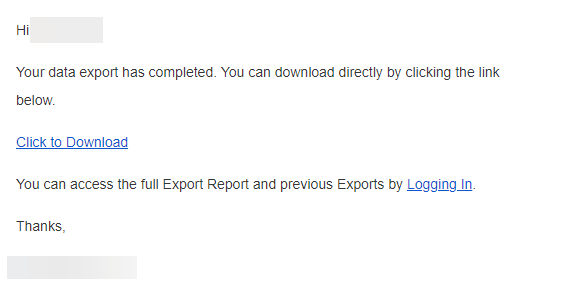
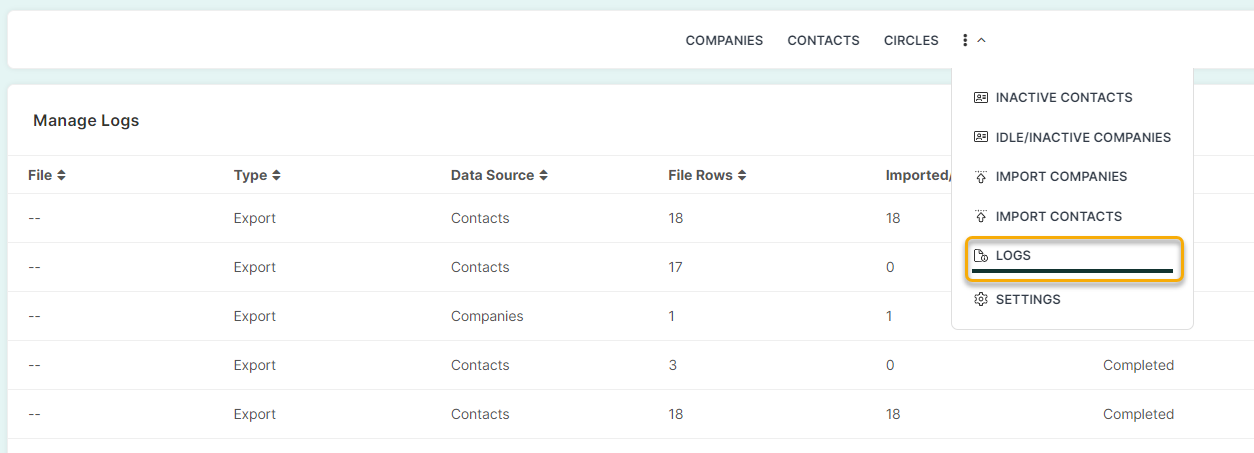
On this page you will have the options to Download or Delete previous exports.